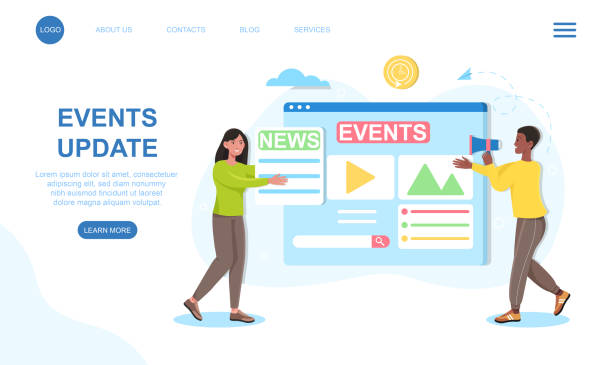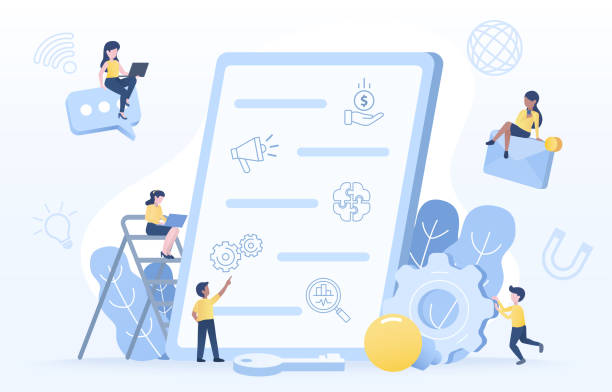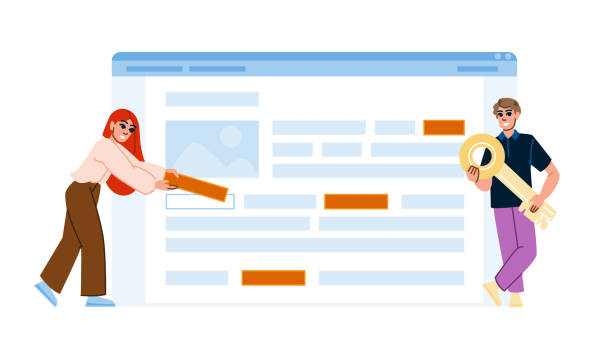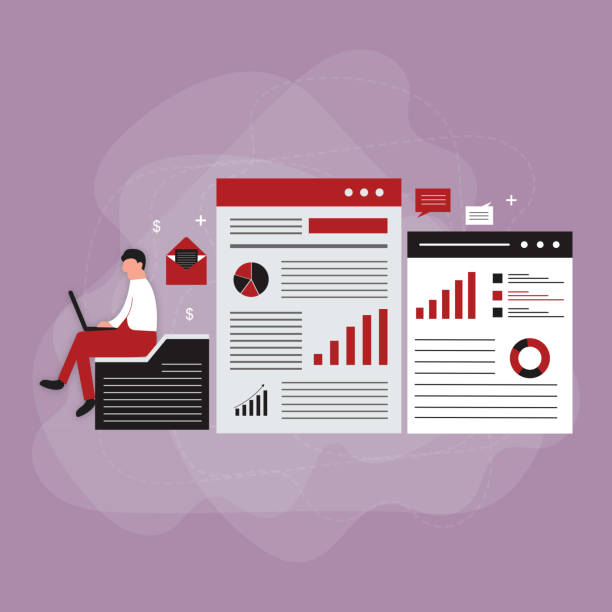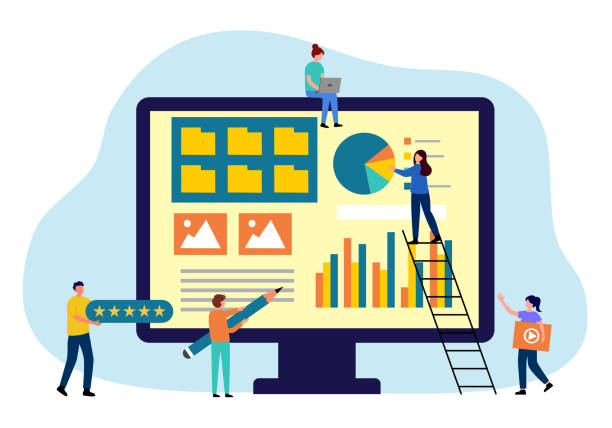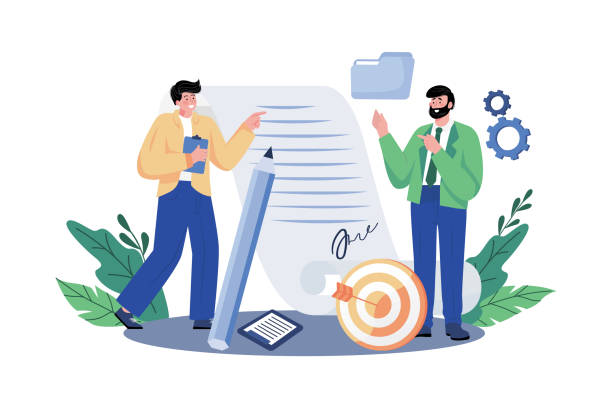Introduction and Importance of Multilingual Website Design
In the era of #globalization and the expansion of the #internet, geographical boundaries have lost their former meaning for businesses.
With billions of people accessing cyberspace, the necessity of an #online_presence is felt more than ever.
But is simply having a website enough to enter the #global_market? The answer to this question lies in #effective_communication with audiences from different cultures and languages.
This is where the concept of multilingual website design gains vital importance.
A multilingual website not only allows you to convey your message in the native language of your potential customers, but also strengthens your digital marketing.
This approach means going beyond mere translation and paying attention to content localization, culture, and even user experience.
Understanding the needs and preferences of audiences in different parts of the world is the key to success in this area.
Multilingual website design is not merely an additional feature, but a smart strategy for business growth and expansion on an international scale.
This approach helps businesses have a stronger presence in e-commerce and capture a larger share of the global market.
Are you dissatisfied with the low conversion rate of visitors to customers on your e-commerce site?
Solve this problem permanently with professional e-commerce site design by Rasav!
✅ Increase visitor-to-customer conversion rate
✅ Create an excellent user experience and build customer trust
⚡ Get free consultation
Competitive Advantages of a Multilingual Website
Having a multilingual website brings countless competitive advantages for businesses, extending beyond mere linguistic communication.
The first and perhaps most important advantage is expanding access to new markets.
With multilingual site design, you can convey your message to millions of others who speak different languages, thereby significantly increasing your potential customer base.
This is especially vital for businesses looking to export their services or products.
Secondly, improving user credibility and trust is another key advantage.
When a user navigates your site in their native language, they feel more comfortable and trust your brand more, which in turn leads to increased conversion rates and customer loyalty.
Multilingual websites often perform better in international search results, as search engines can more effectively index your content for users in different regions and languages.
This means better SEO and more organic traffic.
Also, creating differentiation from competitors who still operate in only one language is a significant advantage.
Finally, an international website can help collect valuable data from various markets, which will be very useful for analyzing consumer behavior and developing future marketing strategies.
Collectively, these factors set your business on a path of sustainable growth and global success.
Technical and Cultural Challenges in Multilingual Web Design
The process of multilingual website design, despite its numerous advantages, is not without challenges.
These challenges can be divided into two main categories: technical and cultural.
From a technical perspective, one of the biggest obstacles is content and database management.
Ensuring that all content, including text, images, and forms, is correctly translated and displayed for different languages requires a robust and flexible Content Management System (CMS).
Choosing the appropriate URL structure for each language (such as subdomains, subdirectories, or parameters) is also vital for international SEO.
Furthermore, optimizing loading speed in different regions of the world and ensuring the correct functioning of scripts and plugins in various languages are other technical concerns.
On the other hand, cultural challenges are equally important.
Localization goes beyond simple word translation; it involves understanding cultural differences, customs, color preferences, symbols, and even how numbers and dates are displayed in different cultures.
Content that is perfectly normal and accepted in one culture may be offensive or confusing in another.
Therefore, for successful multilingual website design, we need not only native translators but also localization specialists who can adjust content and user interface to align with the cultural sensitivities of the target audience.
Failure to pay attention to these points can seriously damage your brand’s credibility.
These challenges require a comprehensive approach and close collaboration between technical and marketing teams for multilingual web development.
| Aspect | Main Challenge | Proposed Solution |
|---|---|---|
| Technical | URL Management and International SEO | Use of hreflang tags, subdomains, or subdirectories |
| Technical | RTL/LTR Support | Flexible CSS design with direction change capability |
| Cultural | Content Localization | Use of native translators and localization specialists |
| Cultural | Image and Symbol Selection | Attention to cultural sensitivities and avoidance of ambiguous images |
| Technical | Integration with Local Payment Systems | Research and implementation of popular payment gateways in each region |
Search Engine Optimization (SEO) for Multilingual Websites
One of the most important aspects of multilingual website design is ensuring its visibility in search engines across different target markets.
Multilingual SEO goes beyond keyword translation and requires a comprehensive and precise strategy.
The first step is choosing the appropriate URL structure.
As mentioned earlier, one can use top-level domains for each country (e.g., .de, .fr), subdirectories (example.com/fr), or subdomains (fr.example.com).
Each has its pros and cons, but the important thing is that search engines can correctly identify the different language versions of your site.
Proper use of the `hreflang` tag in the HTML header or in sitemaps is of paramount importance.
This tag tells search engines which version of a page is suitable for a specific language or geographical region, preventing “duplicate content” issues.
Keyword translation must also be done carefully; mere literal translation is not enough, and local keyword research must be performed for each language to ensure you target words that native users actually use.
Additionally, creating high-quality and relevant content for each language, acquiring backlinks from reputable websites in target markets, and optimizing page loading speed for users in different regions of the world all contribute to improving the SEO ranking of your international website.
These measures increase organic traffic and allow you to reach new audiences.
Does your current website build the trust that potential customers should have in your business? If not, it’s time to have your professional and influential corporate website with Rasav.
✅ Fully customized design tailored to your brand identity
✅ Increase lead generation and your business’s credibility in the eyes of customers⚡ Contact us for a free consultation!
Common Tools and Platforms in Multilingual Website Design
To facilitate the process of multilingual website design, various tools and platforms are available, each offering its unique features and capabilities.
Choosing the right tool depends on your project’s needs, budget, and complexity.
Content Management Systems (CMS) like WordPress with plugins such as WPML or Polylang are the most popular choices for many small and medium-sized businesses.
These plugins enable easy translation management, language switching, and multilingual SEO.
For larger and more complex projects, enterprise CMS platforms like Drupal or Joomla also offer powerful multilingual capabilities.
In addition to CMSs, Translation Management Systems (TMS) as a service, such as Transifex, PhraseApp, or Smartling, are specifically designed for managing and coordinating large-scale translation processes.
These platforms facilitate collaboration among translators, editors, and project managers and often come with features like Translation Memory and #Machine_Translation to increase speed and reduce costs.
Some more advanced solutions also use Content Delivery Networks (CDN) to improve website loading speed in different parts of the world.
Finally, web analytics tools like Google Analytics are also essential for monitoring the performance of different language versions of the site and understanding international user behavior.
The wise selection of these tools will be the cornerstone of a successful multilingual site.
Click here to preview your posts with PRO themes ››
Effective Content Management and Translation
Quality and accuracy in content translation are among the most important factors for the success of a multilingual website design.
Translating words alone is not enough; content must be localized to align with the culture and sentiments of local audiences.
The first step in this process is meticulous planning for translatable content.
It must be determined which parts of the website (texts, images, videos, forms, error messages, and even button texts) require translation.
Next, choosing the translation method becomes important.
Human translation by native translators yields the most accurate and high-quality results and is recommended for sensitive or marketing content that requires a specific tone and nuance.
Machine translation (such as Google Translate) can be used as an auxiliary tool for initial translation or for less critical content, but it always requires human review and editing.
A combination of these two methods (machine translation with human editing) can be a cost-effective and efficient solution.
Utilizing Translation Memory (TM) and Glossaries helps ensure consistency of terminology and reduces translation time and cost in the long run.
Furthermore, the review and quality control process after translation is crucial.
This includes review by a second translator, and finally, a localization reviewer who ensures the content is not only linguistically correct but also culturally appropriate.
Platforms that offer translation previews in the actual website environment will be very useful at this stage.
A multilingual website that offers high-quality and localized content will have a much greater impact.
User Experience (UX) in Multilingual Website Design
A successful multilingual website design must not only be technically flawless but also provide an unparalleled User Experience (UX) for all audiences, regardless of their language and culture.
Multilingual UX design involves considering subtle cultural differences in navigation, layout, and user interface (UI) elements.
The first step is easy language selection.
The language switcher should be clearly visible and accessible, typically at the top of the page or in the footer.
Instead of country flags, it’s better to use language names, as a language might be spoken in several countries (e.g., Spanish), and flags can be misleading.
Responsive design that adapts well to different writing directions (right-to-left like Persian and Arabic, or left-to-right) is essential.
This includes changing the direction of text, images, and the overall layout of page elements.
Fonts must also be suitable for each language and capable of correctly displaying all characters.
Furthermore, the selection of colors and icons must be done carefully; a color symbolizing joy in one culture might represent sadness in another.
Date, time, currency, and measurement systems must also be localized based on local standards.
A localized user experience not only increases user satisfaction but also reduces bounce rate and enhances user interaction with the site.
A multilingual website that prioritizes UX principles will quickly establish itself in international markets and contribute to the overall performance improvement of the multilingual site.
Click here to preview your posts with PRO themes ››
| UX Element | Multilingual Considerations | Importance |
|---|---|---|
| Language Selector | Clear and accessible, use language names instead of flags | Increase usability and accessibility |
| Text and Layout Direction | Full RTL and LTR support, appropriate layout | Readability and visual appeal for all languages |
| Fonts and Typography | Selection of readable fonts for each language, character support | Preservation of visual identity and text readability |
| Forms and Input Fields | Date, time, address formatting consistent with local culture | Reduction of errors and increased form completion |
| Visual Elements (Colors, Icons) | Attention to cultural meanings of colors and icons | Prevention of misunderstanding and enhancement of communication |
Common Mistakes and Ways to Avoid Them
On the path of multilingual website design, there are some common mistakes that can render efforts fruitless or even harm the brand.
Understanding these mistakes and knowing how to avoid them can smooth the path to success.
One of the most common errors is translating words literally without considering cultural localization.
As mentioned previously, content must align with the cultural context of the audience, not just be a literal translation.
For example, a joke or colloquialism in one language might be meaningless or even offensive in another.
The solution is to always use native translators and localization specialists.
Another mistake is neglecting multilingual SEO.
Without proper `hreflang` tags, local keyword research, and the correct URL structure, your website will not be visible in search engines.
To counter this, develop a comprehensive international SEO strategy from the outset.
Insufficient testing of the website in different languages can also lead to a poor user experience.
Issues related to layout (such as text overlapping in right-to-left languages), font display, or date and time formats should be identified and resolved before publication.
Using country flags instead of language names in the language switcher is another common mistake to avoid, as many languages are spoken in multiple countries.
Your international website should be usable by all users without discrimination.
Finally, failure to regularly update translated content can lead to outdated information or inconsistencies between language versions.
A regular content maintenance and update process is essential for all languages.
By avoiding these mistakes, your multilingual web development will be much more successful.
Are your online sales not as expected? With Rasav, permanently solve the problem of low sales and poor user experience!
✅ Increase visitor-to-customer conversion rate
✅ Create an enjoyable user experience and increase customer trust
⚡ Act now to get a free consultation!
Future Trends in Multilingual Web Development
The world of multilingual web development is constantly evolving, with new trends emerging that outline the future of this field.
One of the most important trends is the ever-advancing progress of Machine Translation (MT) using Artificial Intelligence and deep learning.
These technologies have reached a point where they can provide very high-quality translations close to human translation, especially for general texts.
It is expected that in the future, the role of MT in the initial content translation for a multilingual site will become more prominent, though the need for human editing and localization will still remain.
Personalizing content based on the user’s geographical location and language is another key trend.
By utilizing location data and user language preferences, websites can offer much more relevant and customized content, significantly improving the user experience.
The development of Progressive Web Apps (PWAs), which perform like native applications and offer a more integrated user experience, is also on the rise.
These PWAs must also have multilingual capabilities at their core.
Increased attention to multilingual audio and video content is also an important trend.
With the rising popularity of podcasts, videos, and live streaming, providing subtitles, dubbing, or multilingual audio versions for this type of content will become essential for inclusive multilingual site design.
Finally, increased focus on privacy and data regulations (such as GDPR) globally will impact how international user data is collected and used, increasing the need for multilingual and compliant solutions.
These trends indicate that multilingual website design is moving towards becoming smarter, more personalized, and more inclusive.
Click here to preview your posts with PRO themes ››
Why Your Business Needs an International Website?
In today’s world, the question is not whether your business needs a multilingual website or not, but rather why you haven’t taken action for multilingual website design yet? Given the growing global connectivity and increased competition across all industries, the only way for sustainable growth and reaching full potential is to expand horizons and look beyond geographical borders.
An international website allows you to offer your products and services to new markets where there is abundant potential demand for them.
This isn’t just for large corporations; even small and medium-sized businesses can attract customers from across oceans with multilingual website design.
Imagine you have a unique product that is less known in your country but could address a crucial need in another.
Without a website that speaks the language of that country, you can never reach those customers.
In addition to market expansion, increasing brand credibility is also a significant advantage.
A professional multilingual site demonstrates your commitment to serving global customers and your long-term vision.
This can differentiate you from competitors who have settled for only the local market and project the image of a pioneering and innovative brand.
Ultimately, improving user experience and increasing conversion rates for international audiences means increased sales and profitability.
This investment is not just an expense; it’s a necessary and smart step for the future of your business in today’s connected world.
Start thinking about multilingual web development right now!
Frequently Asked Questions
| Question | Answer |
|---|---|
| What is multilingual website design? | The process of building a website whose content is available to users in more than one language. |
| Why should we make our site multilingual? | To reach a wider global audience, improve user experience for non-native users, and increase sales or engagement. |
| What are the methods for implementing a multilingual site? | Using subdomains, subdirectories, or URL parameters, or using different top-level domains (TLDs) for each language. |
| Which method is better for SEO? | Generally, using subdirectories (e.g., example.com/fa/) is recommended for SEO, as they share the main domain’s authority. |
| What is the hreflang tag and what is its use? | The hreflang tag is an HTML attribute that helps search engines understand which version of a page is appropriate for a specific language or region. |
| Is machine translation sufficient for multilingual site content? | Usually no. For providing a good user experience and maintaining credibility, professional translation and content localization are essential. |
| What does Localization mean? | The process of adapting content, design, and site functionality to the culture, language, currency, and other specific characteristics of a target region or country. |
| What is the importance of language selection in multilingual website design? | Users should be allowed to easily select their desired language, usually via a clear button or menu in the site header. |
| What challenges exist in multilingual website design? | Content management in different languages, maintaining consistency in design and user experience, multilingual SEO, and translation and maintenance costs. |
| What features should a suitable Content Management System (CMS) for a multilingual site have? | It should allow for easy content management in different languages, support multilingual URL structures, and provide relevant translation and localization plugins. |
And other services of Rasav Advertising Agency in the field of advertising:
Smart Link Building: Professional optimization to increase website traffic using precise audience targeting.
Smart Sales Automation: A quick and efficient solution to increase click-through rates, focusing on attractive UI design.
Smart Digital Advertising: An innovative platform for improving digital branding with precise audience targeting.
Smart Customer Journey Map: A professional solution to increase website traffic focusing on SEO-driven content strategy.
Smart UI/UX: A combination of creativity and technology for digital branding through precise audience targeting.
And over hundreds of other services in the field of internet advertising, advertising consultation, and organizational solutions.
Internet Advertising | Advertising Strategy | Advertorial
Resources
? To elevate your business in the digital world, Rasav Afarin Digital Marketing Agency, specializing in SEO, online advertising, and user-friendly website design, is by your side to ensure a powerful and lasting presence.
📍 Tehran, Mirdamad Street, Next to Central Bank, Southern Kazerun Alley, Ramin Alley, No. 6

